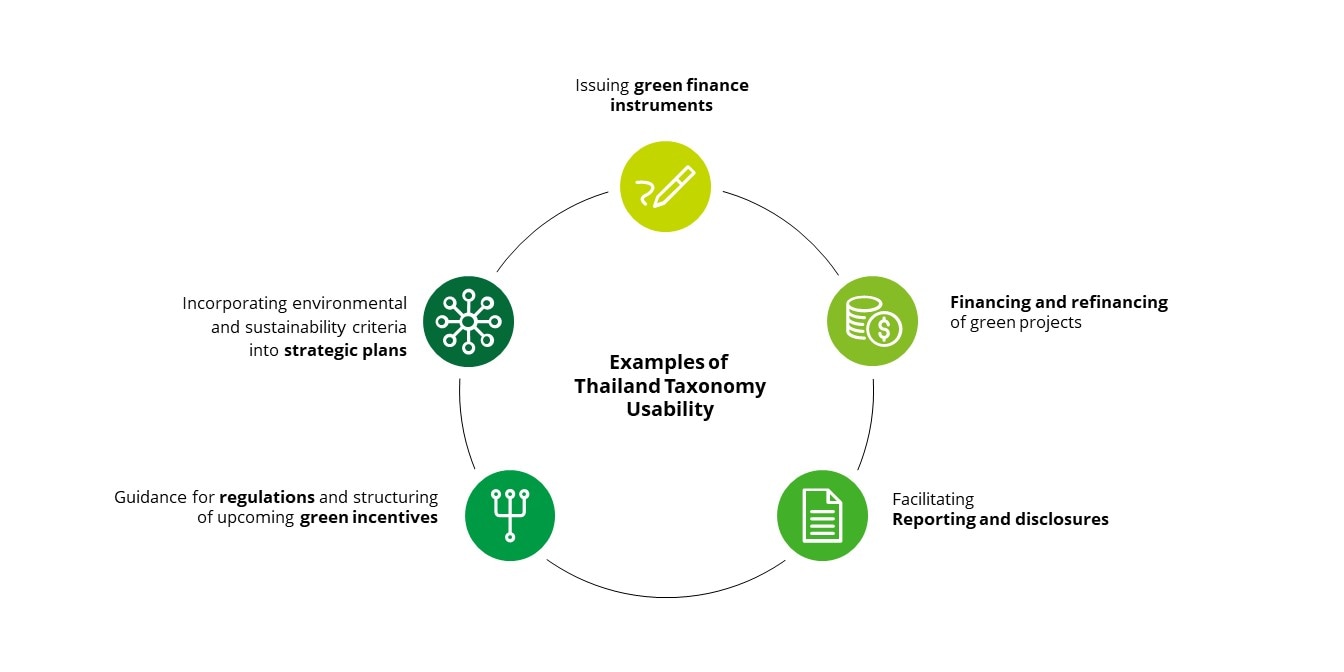Perspectives
Thailand Taxonomy
A crucial step towards a sustainable finance landscape
At the end of 2022, we saw a significant movement in sustainable finance through the issuance of the first draft of the Thailand Taxonomy. The national taxonomy will have key impacts for business in their transition to low-carbon economy. It is therefore crucial for stakeholders, including the business and financial sector, to understand what taxonomies are and how it will be used in the future.
To understand the background, the development, and Deloitte’s full analysis of the first draft of Thailand Taxonomy. Click the link below: Section 1: Sustainable Finance Landscape in Thailand |
The public hearing of the draft by the Bank of Thailand (BOT) and the Security and Exchange Commission (SEC) open until 26th January 2023. The full draft of Thailand Taxonomy can be accessed here.
A taxonomy is a classification system, establishing a list of sustainable economic activities. While taxonomies can also cover all ESG activities, Thailand Taxonomy is a Green Taxonomy which focuses on environmentally sustainable economic activities. A green taxonomy includes a set of criteria (technical or qualitative) defining or list of activities that deemed green (Gondijian and Merle, 2022). Green taxonomy specifies environmental objectives and list the activities contributing to the objectives or principles to identify the activity as green, sector in focus, and implementation method.
Objectives of Thailand Taxonomy
The Bank of Thailand (BOT) defines a green taxonomy as a “guide to climate aligned projects and assets” (2022). It is a tool for bond issuers, financial institutions, statistical agencies, investors governments and municipalities to help them understand and make informed decisions on investments for activities that contribute to a low-carbon economy.
Looking from the business perspective, Thailand Taxonomy can be used and applied for a variety of purposes as shown below:

About Thailand Taxonomy
The main elements of the draft Taxonomy, which is aligned with 1.5°C scenario, are as follows:
The Focus: to define activities that reduce GHG emissions to achieve the climate change mitigation objectives in line with Thailand’s climate policy and international obligations.
The Environmental Objectives: The Taxonomy is designed to cover six environmental objectives, although the first version of the Taxonomy will only develop the screening criteria and thresholds for climate change mitigation (Objective 1) to start. It is intended that future versions of the Thailand Taxonomy will be expanded to include all six objectives: (1) Climate change mitigation; (2) Climate change adaptation; (3) Sustainable use and protection of marine and water resources; (4) Protection and restoration of biodiversity and ecosystems; (5) Pollution prevention and control; and (6) Resource resilience and transition to a circular economy.
“ The first Thailand Taxonomy is a green taxonomy listing activities with the environmental objective of ‘climate mitigation’, focusing on the first 2 sectors:
Energy and Transportation
In later phases, the Taxonomy will expand to cover 6 environmental objectives in 5 economic sectors (number of sectors planned as of 2023). “
Economic Sectors: the first version of the Thailand Taxonomy limit its scope to the Energy sector and Transportation sector. Other sectors to be in the subsequent phases include industrials, agriculture, and water & wastewater supply, processing & remediation.
How to use Thailand Taxonomy
The draft listed out the economic sector and the rationale for sector prioritization, the models used for activities assessment and modelling, the relevant thresholds and criteria to identify green, amber or red activities, and essential criteria for eligible activities.
While this may sound daunting for general business practitioners, the following 3 steps can guide to using the taxonomy for economic activities assessment:
- Break down operations in the eligible sectors into economic activities
- Assess activity against Technical Screening Criteria
- Ensure compliance with ‘Do No Significant Harm’ (DNSH) & meet ‘Minimum Social Safeguards’ (MSS) and prepare final report
Impacts & Challenges
Again, the taxonomy is a classification system, not a compulsory list of activities or reporting requirements. Therefore, the official issuance of the taxonomy will not drastically change the business operational nor the sustainable financial landscape just yet. However, we can observe a list of future challenges and implications to look out for:
The implications of data requirements – more data and transparency needed: Since the Technical Screening Criteria requires a certain level of data granularity. Companies will need to improve data collection on their green initiatives.
Changing criteria in future iterations – the taxonomy is a living document: Given the changing nature of the Technical Screening Criteria, the taxonomy is a living document and companies will need to adjust and plan their green activities in line with the future versions of taxonomy and technology advancement.
Surrounding regulations around the use of taxonomy – good rules to operationalize the classification: For the wider usage of the taxonomy in promoting sustainable finance and accelerating transition to net-zero, relevant regulators will enact laws and regulations that will work together with the classification to see such affect. Companies will need to adapt once these changes are established.
Question of interoperability – different classification leads to limited synchronized identification of green activities: This is the challenge at the international level. The level of interoperability will impact the attractiveness and investment decisions of international investors in green assets and projects.
Thailand Taxonomy is one of the core developments in the sustainable finance landscape. The new set of criteria and thresholds for other sectors, covering all six environmental objectives, will be adopted in the near future. We believe that the first draft is an immense step forward and stakeholders will soon understand more on its usability and the significance of Thailand Taxonomy in our transition to net-zero economy.
References
• Bank of Thailand, “Thailand Taxonomy Paper: Draft for public consultations,” 2022.
• Gondijian, Garnik and Cédric Merle, “Sustainable Taxonomy development worldwide: a standard-setting race between competing jurisdictions,” Natixis, July 29, 2021.
